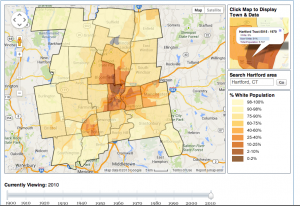Author: Christina Raiti
Exercise 8 One Nation Indivisible
Cities, Suburbs, Schools
11/9/13
Last Friday, November 8, I was able to attend a conference titled Where Integration Meets Innovation. This conference was held at the Hartford Public Library and its main purpose was to aid in the Sheff Movement Coalition. The conference had a very reputable panel with representatives such as Martha Stone, Dennis Parker, Amy Wells, Alex Knopp, Robert Cotto, and Elizabeth Horton Sheff herself.
At first I was not sure how the conference would work. I was very nervous that I would be asked questions and I had never been to anything quite like it. The group of students who attended decided to split the conference up into sections by speakers. I chose to represent Martha Stone. Martha Stone is the lead attorney for the Plantiffs in the Sheff vs. O’Neill court case. We have been studying this case for some time in class and it was truly an experience to see the actual brains behind the ideas. Stone began her panel discussion by opening with two dates. She said “April 27, 1989 and July 9, 1996”. She proceeded to speak about how the lawsuit began twenty-four years ago and the decision was seventeen years ago. She said they always begin each topic with Langston Hughes’s differed dream quote. “What happens to a dream deferred? Does it dry up like a raisin in the sun? Or fester like a sore– And then run? Does it stink like rotten meat? Or crust and sugar over– like a syrupy sweet? Maybe it just sags like a heavy load. Or does it explode?” This quote was meant to show everyone that everybody deserves an equal chance at dreaming. She then spoke about how in 1987 civil rights advocates approached her and how this was before Elizabeth Horton Sheff was even involved. At first Hartford made it very clear that they did not want this lawsuit in any way shape or form.

Stone started to explain the exact reasoning for the lawsuit. She said in 1987 and 1989 mastery tests were administered. Hartford kids scored significantly lower than other Connecticut kids. This was the first time that the difference in educational quality became very clear. Over seventy-five percent of the children in Hartford needed extra help with basic reading. This was a number Stone felt was absurd.
Finally Stone ended with a saying that I really thought was powerful. She asked if the glass was half empty or if the glass was half full. She said the answer was yes. Stone followed by saying until the glass is all-full the law suit will continue. There is no equal education in isolation. This conference provided the community with a lot of information both facts based and hopeful wishes. Sheff and Stone intend to make it equal for all kids to achieve their dreams. I was honored to be apart of the conference and the Hartford Public Library provided a beautiful space for a truly inspirational conference aimed for parents, educators, scholars, and activists.
How to Lie with Maps
Both of my maps are the same however, they are manipulated differently. The first map shows racial diversity by increasing the number of buckets. By increasing the number of buckets this alters the scale which allows for more district variation. The second map has two buckets which would show less contrast on the map. Changing the buckets allows for different colors to represent different numbers which would ultimately change the shading percentages.
2009-10 Hartford Area School District Racial Diversity
2009-10 Hartford Area School District Racial Division
Zoning
Zoning: Emancipative or Restrictive?
In the early 1900s, leaders of West Hartford sought to implement zoning restrictions. West Hartford was a farming town with nearly as many cows as people and was hopeful of becoming a larger residential suburb for workers from the city of Hartford to escape to. (Butterworth 23). Intended or not, there were repercussions that occurred due to the Zoning Act of 1924. Today, we still see similar statistics, which leads us to believe there could be a correlation between zoning and racial segregation.
The 1924 zoning committee planned to be the first in the area to create these regulations. Robert Whitten came to Hartford by invitation from the committee and was wanted on board for his intelligence and persistence. The committee wanted zoning to create a desirable community for people leaving the city of Hartford in hope of finding peace and space. The Zoning Acts were developed in an attempt to ensure the calmness and quality size of the land. “On the economic side, zoning means increased industrial efficiency and the prevention of enormous waste. On the human side, zoning means better homes and an increase of health, comfort and happiness for all the people.” (Whitten Cover). Zoning was also used to keep the area neat, eliminate trash, and provide people with reassurance that their property would be safe and protected from a decrease in value.
What Was the Plan?
The Hartford Zoning Committee covered many aspects in regards to building restrictions in their proposal. West Hartford was to be divided into three areas: residential, business, and industrial. Each section had its own restrictions as to what was allowed. There were a lot of restrictions within the residential district. Sidewalks were to be set 20 to 40 feet back from the road in order to ensure less traffic and more parking availability. Every building area was allowed to have a garage. However, the larger the lot, the greater amount of cars was permitted. (Whitten12). There were also regulations included to avoid obstruction of view, regulate side and front yards, and unify the height of all structures.

The document specified that for a large amount of money you could live in a certain area and have the entire lot to yourself. For a lesser amount of money, you could still be in the town, but it was a smaller section and the houses were not only smaller but they were right on top of each other. Ultimately, this was an attempt to segregate the town into rich and poor. “It is recognized, however, that it would be unwise to implement any rule of this kind. It is quite likely that it limited portions of these areas provision for two family houses, group houses and even apartment houses will be economically and socially desirable.” (Whitten 14). Entirely, West Hartford was considered economically undesirable to all families who were not financially capable of purchasing under the new regulations. It deterred people from building multi-family houses and promoted the purchase of single-family pricier homes.
The Hidden Plan
Zoning may not have been the sole cause of the current wage gaps of residents in West Hartford vs. Hartford. However, it is apparent that zoning laws had an influential role in segregating people by income. Consequently, people who were left unable to afford the new property were left to settle in Hartford. Race and income are very commonly linked which meant that the poor minorities were primarily located in Hartford while the white middle class settled in West Hartford. The Zoning Act of 1924 made West Hartford a very exclusive, privileged place to live.
Zoning Today
The Zoning Act was put in place to accommodate all classes of people/workers who were migrating from the city of Hartford. Today, if we look at a map showing racial change in Hartford, it becomes evident that the surrounding suburbs are 90-100 percent occupied by white residents. (Magic Lib 1). In an attempt for equality, the zoning laws inadvertently caused the minorities to settle in the poor city of Hartford. Hartford is filled with apartment buildings and complexes that accommodate multiple families. The suburbs lend themselves to single family homes, which allow for a higher class of residents to purchase property. In addition to a differentiation in location of races in the Hartford area, today there are also significant differences in household income when comparing Hartford and West Hartford. (Social Explorer). West Hartford’s average household income is $80,061 while Hartford’s is $29,107.

Zoning originated as a proposition for a safer, healthier, community. The commissioners, along with Robert Whitten, proposed rules and regulations that would ensure stability. Whether or not zoning directly caused racial and economic segregation is a question largely debated? What we do know is that the area of Hartford and the surrounding suburbs are not areas of equal emancipation when it comes to opportunities in life. Clearly the effects of zoning demonstrate segregation. Perhaps the question should be: “Was there a hidden agenda when zoning was implemented?”
Works Cited
Butterworth, Miriam, Ellsworth S. Grant, and Richard Woodworth. Celebrate! West Hartford: An Illustrated History. West Hartford, CT: Celebrate West Hartford, 2001. Print.
“Racial Change in the Hartford Region, 1900-2010” University of Connecticut Libraries Map and Geographic Information Center – MAGIC . Web. 20 Jun. <http://magic.lib.uconn.edu/otl/timeslider_racethematic.html>.
Social Explorer Tables: ACS 2007 to 2011 (5-Year Estimates) (SE), ACS 2007 — 2011 (5-Year Estimates), Social Explorer; U.S. Census Bureau
Whitten, Robert Harvey, West Hartford Zoning: Report to the Zoning Commission on the Zoning of West Hartford (West Hartford, Conn: Zoning Commission, 1924),
“Zoning Maps of West Hartford, Connecticut, 1924 to Present.” University of Connecticut Libraries Map and Geographic Information Center – MAGIC . Web. 20 Jun. 2012. <http://magic.lib.uconn.edu/otl/dualcontrol_zoning_westhartford.html>.
Plagiarism
Ed 300
Assignment 4
Plagiarism
Part 0: Finding Good Mommies pg 102-109
Part 1: But it was more than that. He was saying that we lived in Westport because our parents are smarter and that people in Bridgeport aren’t as smart and that’s why they are where they are. As if this were a natural selection.
Part 2: The lawyers then questioned whether or not they could present the state with the large suburban and urban achievement differences.
Part 3: There were two sets of parents who were on the same side and always went to the meetings with one another. The parents asked the Hartford Board of Education tough questions. (Eaton 104).
Part 4: After attending the meeting for the school, Sheff was shocked in what she found. Previous to attending the meeting, Sheff was aware the area was largely segregated however she had no idea that ninety-one percent of the students in Hartford belonged to minority groups. (Eaton 107).
Part 5: Sheff was very intelligent and enticed everyone to listen when she spoke. Sheff never went to college but managed to be very knowledgeable about the issue. Sheff spoke boldly about controversial topics such as tax dollars being spent and where the money was going. It was clear she was going to have quite the effect on this case. “Elizabeth Horton Sheff hit the moral center when she spoke out. ‘We listened to her,’ Brittain said. ‘And we suddenly felt lucky.’” (Eaton 109).
Actual Book Citation:
Eaton, Susan. “Finding Good Mommies.” The Children in Room E4. N.p.: n.p., n.d. 102-09. Print.